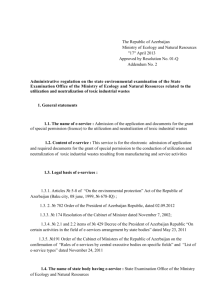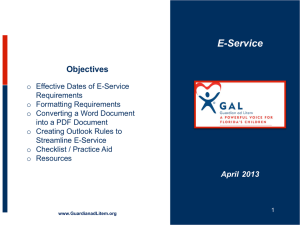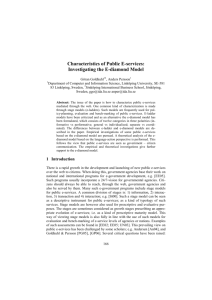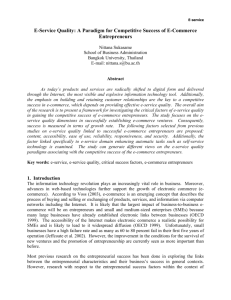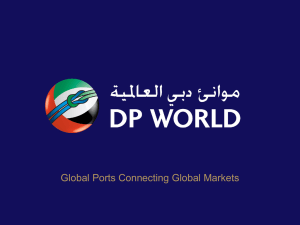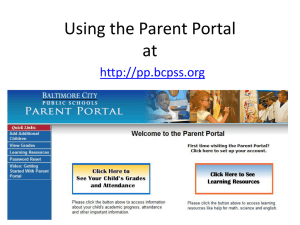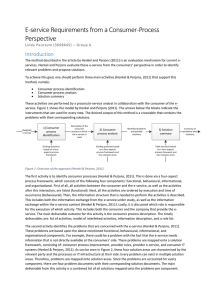e-services ToT module1
advertisement
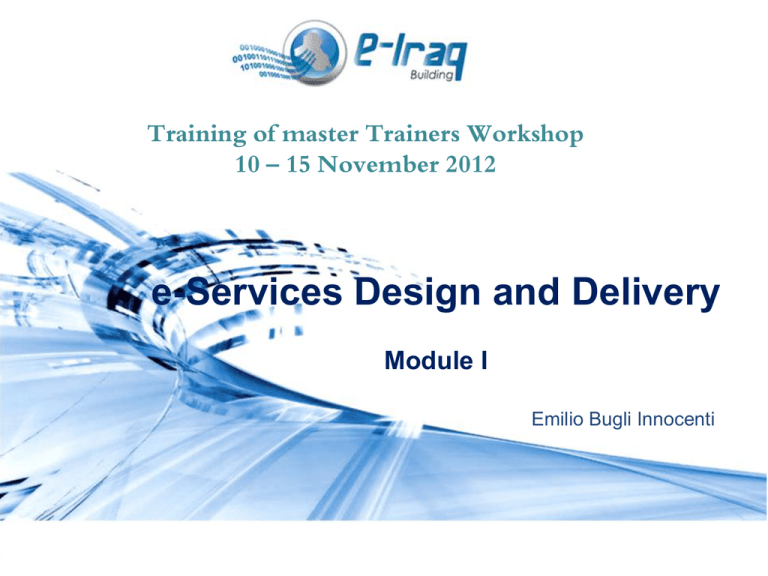
Training of master Trainers Workshop 10 – 15 November 2012 e-Services Design and Delivery Module I Emilio Bugli Innocenti e-Services Design & Delivery Contents of Module I - “e-Services Design & Delivery” e-Service Definition The e-Service Presence Beyond the e-Service Presence Life Event and One-Stop-Shop Portal The Front End and the Back End Approach e-Service Definition e-Services, a business concept developed by Hewlett Packard (HP), is the idea that the World Wide Web is moving beyond ebusiness and e-commerce (that is, completing sales on the Web) into a new phase where many business services can be provided for a business or consumer using the Web. Some eservices, such as remote bulk printing, may be done at a Web site; other e-services, such as news updates to subscribers, may be sent to your computer. Other e-services will be done in the background without the customer's immediate knowledge. HP defines e-services as "modular, nimble, electronic services that perform work, achieve tasks, or complete transactions e-Service Definition Rowley (2006): “…deeds, efforts or performances whose delivery is mediated by information technology. Such e-service includes the service element of e-tailing, customer support, and service delivery”. This definition reflect three main components- service provider, service receiver and the channels of service delivery (i.e., technology). For example, as concerned to public e-service, public agencies are the service provider and citizens as well as businesses are the service receiver. The channel of service delivery is the third requirement of e-service. Internet is the main channel of eservice delivery while other classic channels (e.g. telephone, call center, public kiosk, mobile phone, television) are also considered e-Service Definition • E-Service (or ‘eService’) is a highly generic term, usually referring to ‘The provision of services via the Internet (the prefix 'e' standing for ‘electronic’, as it does in many other usages), thus e-Service may also include e-Commerce, although it may also include non-commercial services (online), which is usually provided by the government.’ (Irma Buntantan & G. David Garson, 2004: 169-170; Muhammad Rais & Nazariah, 2003: 59, 70-71). • ‘e-Service constitutes the online services available on the Internet, whereby a valid transaction of buying and selling (procurement) is possible, as opposed to the traditional websites, whereby only descriptive information are available, and no online transaction is made possible.' (Jeong, 2007) The e-Service Maturity Model From a citizen’s perspective, online interaction with public authorities typically takes the form of: obtaining information from public authorities’ websites downloading official forms or sending filled-in forms Online public services for businesses for interacting with public authorities are either used for: obtaining information obtaining forms returning filled in forms full electronic case handling submitting a proposal in an electronic tender system (eprocurement). The e-Service Maturity Model Online public services are therefore differentiated into: information services (e.g. obtaining information from authorities websites) communication services (e.g. making an appointment online with a practitioner) transaction services (e.g. receiving and sending filled in forms) The e-Service Maturity Model Stage 0 The service provider or the administrative responsible level does not have a publicly accessible website or the publicly accessible website managed by the service provider or by the administrative responsible level does not qualify for any of the criteria for the stages 1 to 4 Stage 1 Information: online information about the public service - The information necessary to start the procedure to obtain an environment-related permit is available on a publicly accessible website managed by the service provider or by the administrative responsible level. Stage 2 One-way interaction: downloading of forms - The publicly accessible website managed by the service provider or by the administrative responsible level offers the possibility Stage 3 Two-way interaction: processing of forms, including authentication. The publicly accessible website managed by the service provider or by the administrative responsible level offers the possibility of an electronic intake with an official electronic form to start the procedure to obtain an environment-related permit. Stage 4 Transaction: full case handling, decision and delivery/payment. The publicly accessible website managed by the service provider or by the administrative responsible level offers the possibility to completely treat the delivery of environment-related permit via the website. Case handling, decision and delivery of a standard procedure to obtain an environment-related permit can be treated via the web. No other formal procedure is necessary for the applicant via “paperwork”. Stage 5 Personalization: pro-active service delivery, automatic service delivery. The proactive service delivery means that the government pro-actively performs actions to enhance the service delivery quality and the user friendliness. Examples of pro-activity are: the government warns the user that action could be required, the government pre-fills data in the application forms that it already contains in governmental databases to the extent permitted by law. The automatic service delivery means that the government automatically provides specific services being social and economic rights for citizens (and business), linked to a certain condition of the user. There is no need for the user to request the service. The Service Maturity Model THE SERVICE MATURITY MODEL The EU Service Benchmark 20 basic services are considered: 12 citizen-related, 8 business-related Public services for citizens Maximum stage Income taxes 5 Job search services 4 Social security benefits 5 Personal documents (passports / driver's license) 5 Car registration 4B Application for building permission 4 Declaration to police 3 Public libraries 5 Certificates 4 Enrolment in higher education 4 Announcement of moving 4 Health-related services 4B The EU Service Benchmark Public services for businesses Maximum stage Social contributions for employees 4 Corporate tax 4 VAT 4 Registration of a new company 4 Submission of data to statistical offices 5 Customs declaration 4 Environment-related permits 5 Public procurement 4 The EU Service Benchmark The EU Service Benchmark • The 9th EU Service Benchmark states that service presence has reached almost 90% in the EU (we need 10 yeasr to reach such level) • However take up of e-Service among citizens between 15 – 65 age is less 40%! Beyond Service Presence Life event portal Services that are directly related to the solution of a particular problem should be linked or integrated in such a way that the customers gain quick and convenient access to all the services they need in one place, regardless of the distribution of competences between different public agencies and businesses Such approach is called a life-event approach since it integrates services, which are specifically designed around nodes that directly correspond to a particular life-event (e.g. moving a house, starting a business, getting married, etc.). Beyond Service Presence Life-event portal implementation all relevant agencies offering the same service in a common manner, sharing data definitions and at best sharing data, but no technological integration between the services being offered services are collected together under a common theme or event. The services are not inherently integrated, or even with a common look-andfeel, but are grouped in ways that aid discovery and promote the comprehensive completing of necessary services services are delivered by a single provider as an agent of other government agencies. Singular services are offered by the agent and the integration is hidden from the ‘customer’ services are technologically integrated into a supply-chain application. This requires the most sophisticated integration work and is not often implemented Beyond Service Presence Life-event portal implementation From the perspective of more horizontal but in reality networked governance solutions that are the essence of service transformation and effective security strategies, two main issues need to be addressed: how to motivate public managers to share data and, more generally, to work jointly for the public good; and how to understand and overcome the range of barriers, technical, organisation and legal, but also psychological, social and political, affecting cross-agency initiatives Beyond Service Presence A Case Study: Dubai Life-event portal Beyond Service Presence A Case Study: Dubai Life-event portal (www.dubai.ae) Dubai e-GOVERNANCE has collaborated with government departments and private sector organisations to create awareness about the latest innovations in e-Governance and the efficiency of the e-Services being offered by Dubai e-GOVERNANCE, where e-Services provided by more than one government department are integrated into customer focused life events. A strong, unified base to address the needs of the public through more than 2,000 electronic services provided by various government departments in the emirate has been built. Information and services are packaged based on various life stages of individuals, businesses and visitors. This system allows portal users to have direct access to services that they require without having to browse through several web pages Beyond Service Presence Web 2.0 Developments Web 2.0 applications provide decentralised patterns for data submission and analysis, and provide a platform for the provider-user interaction, in contrast to non-interactive websites where users can only passively view information. A range of opportunities for citizen participation are offered by Web 2.0, a term that refers to web applications that facilitate interactive information sharing, interoperability, user-centred design and collaboration. In the particular context of crisis-response funds and their usage, it is generally observed that governments lag behind non-governmental actors Beyond Service Presence Web 2.0 Developments – A Case Study. Bahrain (www.bahrain.bh) Beyond Service Presence Web 2.0 Developments – A Case Study: Bahrain Bahrain’s e-GOVERNANCE programme has been innovative when it comes to customer’s centricity. Citizen involvement has been ensured right from the strategy formulation and continuous feedback has been obtained during implementation. In continuation to this philosophy, the Bahrain eGOVERNANCE program has embraced the Web 2.0 to reach its customers. Ministers and senior government officials have established an open door policy to interact with citizens. The e-GOVERNANCE program has its presence on social networking sites such as Facebook and You Tube. In addition, the national portal and ministry websites provide features such as open forums, blogs, live chats, online polls, e-newsletters and other interactive services that involve citizens in government decision making Beyond Service Presence Web 2.0 Developments – A Case Study: Bahrain For instance, two of the ministers and the CEO of the e-GOVERNANCE Authority have interacted with citizens through such blogs Citizens’ participation and constructive feedback was recognized and implemented by changing the national portal and reprioritizing its objectives, thereby achieving 85 % of customer satisfaction on the eGOVERNANCE programme as per the May 2009 Survey The Front End – Back End Approach From a review of recent e-Gov literature it is possible to identify at least three different approaches to citizen-centered eGovernment: the front-end approach, which focus on the interface or the design of mainly Internet-based applications such as government portals and other services delivered through kiosks or mobile devices; the back-office approach, where governments place emphasis on improving or integrating processes to facilitate provision of citizen services (some times supported by applications such as CRM, GIS or GRP tools) The Front end – Back End Approach an intermediate approach where governments explore citizens' needs and develop specific solutions designed to satisfy some of these needs, including front-end and back-end applications and strategies Front End Approach The fundamental technical requirements of a robust front-end system are associated with allowing citizens to interact seamlessly and smoothly with services provided by government using different platforms and channels Make use of User-Centered Design paradigm considering a variety of techniques, methods and practices such as surveys, focus groups, expert reviews and usability testing Front End Approach UCD basic principles: – Focus on users is to identify and categorize the users; most important is the interaction between designers, decision makers, and users throughout the life cycle of information-technology systems – The concepts of learning and usability should be understood at all stages of online services development – There must be a design to improve and evaluate the performance of the service that will be offered Back End Approach When governments focus on the back-office to increase service delivery effectiveness, it is common that the efforts include some form of integration among government offices encompassing both technical and organizational components to be successful The back-office transformation refers to rethinking and redesigning internal processes and systems based on citizens’ needs. Therefore, instead of modifying only the interface, back office transformation pays greater attention to fundamental processes and flows of information that support any type of government service, even when the service itself cannot be delivered electronically. Back End Approach One component of some of these efforts in the back office consists of the adoption of a Customer Relationship Management (CRM) system, which is a powerful business method that utilizes knowledge about customers to serve them efficiently and effectively. With this tool, governments will be able to get information about what citizens expect, besides that, it helps to optimize population segmentation and enhances the process of building and maintaining relationships between government and citizens A key element of CRM is the continuous communication between government and society that helps to incorporate new information and public services to satisfy citizens’ needs. In different countries where PCRM has been conducted, governments are interested in three variables related with quality: (1) citizen needs fulfillment, (2) interactive communications and (3) segmented and personalized services. In general, society needs are linked to impacts on individual efficiency and citizen satisfaction An Intermediate Approach • Governments need to know citizens’ needs and they should design and develop systems and applications that truly reflect those needs and goals, whether they could become online services or not. • The intermediate approach includes not only electronic services, but also services that cannot be delivered online, but can be supported and improved by using information and communication technologies in fundamental internal processes and functions.
